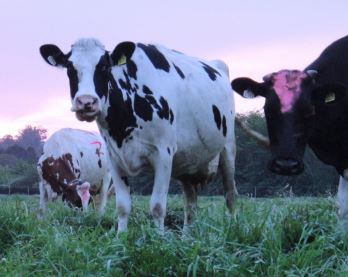



Behaviour of Dairy Cows Grazing Variable Pasture States and Grain-Based Concentrate
Times through the day have a major effect on grazing behaviour in robotic milking systems, although pasture type does too.This is an important feature in the southern hemisphere as pasture-based systems using robots give voluntary cow traffic access to different states of pasture.
This is the premise for a study at the University of Sydney, in which Dr Ravneet Kaur concludes that behaviour patterns were affected by pasture type but the biggest effect was the time of day.
Looking at spring and summer grazing, the experiment set out to determine the impact of pasture state and concentrate allocation on cow behaviour.
How does the state of pasture effect cow behaviour? - A Sydney University project tried to find out
Thinking Behind the Study
Dr Kaur writes: The first cows moving into a fresh pasture allocation are offered high quality fresh pasture than the last cows accessing poorer quality stale (depleted) pasture with high fibre (neutral detergent fibre, NDF) and low protein content.
Moreover, concentrate is offered independent of the pasture quality. Understanding cow behaviour in response to different pasture states and concentrate allocation is needed to develop management strategies in robotic systems.
Method
Ninety mid-lactating dairy cows were offered 4 different states of kikuyu grass (Pennisetum clandestinum) in summer after am and pm milking sessions along with 3 concentrate allocations (3 kg, 6 kg and 9 kg /day).
The 4 different pasture states comprised of 2 consistent (fresh-fresh or stale-stale) and 2 inconsistent (fresh-stale, and stale-fresh) pasture allocations.
After 6 days of adaptation, 36 cows (3 from each treatment) were selected for visual monitoring of grazing behaviour (15 minute intervals).
The experiment was repeated in spring with ryegrass (Lolium multiflorum). Samples were collected from both trials for each pasture state to determine in-vitro dry matter digestibility and nutrient composition.
Charts showing average grazing, lying and rumination behaviour of cows grazing kikuyu in summer and ryegrass in spring.
Findings
ASReml with R software was used to study interactions between pasture states, concentrate level and time of day. We found a significant interaction (P<0.001) between pasture state and time because of the diurnal variation in the grazing and lying behaviour but not (P>0.05) for rumination behaviour.
There was no (P>0.05) interaction between pasture state and concentrate allocation on cow behaviour grazing ryegrass or kikuyu.
On average, there was a higher probability of cows being observed grazing (0.43 vs. 0.37) and lying (0.43 vs. 0.37), and a lower probability of being observed ruminating (0.37 vs. 0.41) with ryegrass (spring) compared to kikuyu (summer) respectively (Figure 1).
These differences could be related to higher in vitro digestibility (73 per cent vs. 68 per cent) and lower NDF content (50 per cent vs. 65 per cent) of ryegrass compared to kikuyu respectively.




